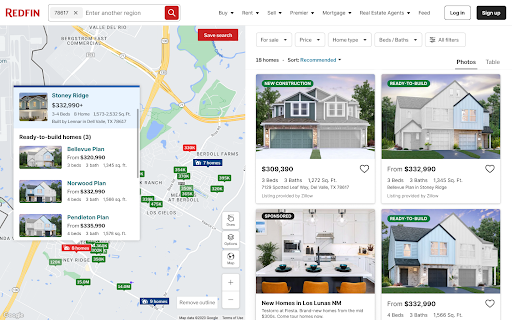Big data is making it possible to predict what will happen in 2025 with greater accuracy than ever before. By analyzing tons of information, like property values, buyer behavior, and the economy’s performance, real estate experts make informed choices.
This data-driven method allows for precise predictions of market changes, assisting investors, developers, and agents in identifying potential opportunities.
In this blog, we’ll talk about the technologies used to analyze it, and how it can be leveraged to forecast key trends in 2025.
Technologies for Analyzing Real Estate Big Data
Here’s a look at the tech essential for analyzing real estate big data.
Data Collection and Storage
Imagine trying to predict the future of real estate by manually browsing through countless websites and public records. It would be a confusing and near-impossible task. Thankfully, technology provides us with efficient ways to gather and store this vast amount of information.
Web scraping acts like a digital assistant, automatically collecting publicly available data from websites like Zillow and Redfin. This includes crucial details like property listings, prices, and neighborhood information, says Dan Close, Founder and CEO at We Buy Houses in Kentucky.
APIs, on the other hand, are like digital messengers that allow different software systems to communicate. Real estate companies use APIs to directly access data from sources like government property records or multiple listing services (MLS), ensuring they have the most up-to-date information. Once collected, this data needs a place to reside.
Data lakes act like massive reservoirs, holding all kinds of real estate information — both structured (like numbers) and unstructured (like text and images). And to ensure this valuable data is accessible from anywhere and securely stored, cloud storage services like Amazon Web Services (AWS) or Google Cloud are employed.
Here, Opendoor is a prime example. This company is disrupting the traditional home-buying process by using big data to make instant cash offers on homes.
Image Source: LinkedIn
They analyze a range of data points, including property characteristics, market conditions, and even neighborhood-level details, to determine a fair market value. This allows sellers to quickly and easily sell their homes without the hassle of listing and showing.
Data Processing and Analysis
Gathering data is just the first step. To understand what’s happening in the market, we need to analyze it. Machine learning (ML) algorithms can sift through mountains of data to identify patterns and make predictions. ML algorithms use various techniques to achieve this – Martin Seeley, Senior Sleep Expert of Mattress Company.
- Regression: Used to predict things like property values based on factors like location, size, and age.
- Classification: Helps categorize properties into different types (e.g., single-family homes, condos) or predict whether a property will sell quickly.
- Clustering: Groups similar properties together, which is useful for market segmentation and identifying investment opportunities.
But it’s not just about numbers. Natural Language Processing (NLP) allows computers to understand human language. This means they can analyze property descriptions, online reviews, and even social media posts to gauge market sentiment and extract key information.
Redfin is a good example here. This real estate brokerage uses big data to provide personalized recommendations to homebuyers.
Image Source: Redfin
Their algorithm analyzes user preferences, search history, and market trends to suggest properties that best match their needs and budget. This helps buyers find their dream home faster and more efficiently. Redfin also uses data to predict the likelihood of a home selling above or below the asking price, giving both buyers and sellers a realistic expectation of the market says Martin Heaton, Director of Reinforcement Products Online.
Data Visualization and Reporting
Even with analysis, raw data can be difficult to understand. Interactive dashboards are like customizable control panels that present complex data in a clear and engaging way. Imagine seeing key market metrics, property performance, and investment opportunities displayed on a single screen, with the ability to drill down for more detail.
Geographic Information Systems (GIS) take this a step further by allowing you to visualize real estate data on maps. This is incredibly helpful for understanding spatial patterns, such as identifying areas with high property values or areas experiencing rapid growth, says Daniel Wade, Owner of Strong Perimeter.
Also, predictive modeling tools combine historical data with current market indicators to generate forecasts. A predictive model might show the likely price appreciation of a property over the next five years, helping investors make informed decisions.
Let’s take an example of Zillow. They use machine learning to power its “Zestimate” tool, which provides estimated property values. They analyze millions of data points, including recent sales, property characteristics, and market trends, to generate these estimates.
Image Source: Real Estate Witch
Although not always perfect, Zestimates have become a widely used reference point in the real estate industry, demonstrating the power of technology in analyzing and presenting real estate data.
Predicting Real Estate Market Trends in 2025
Predicting the future of real estate is no easy feat. It’s a complex influenced by a multitude of factors, from economic shifts and government policies to changing demographics and emerging technologies. But with big data, we can gain a clearer picture of what’s to come in 2025, explains Simon Bernath, Founder of FurnacePrices.ca.
Identify the Vital Signs
Think of the real estate market as a living organism with various vital signs that indicate its health and direction. These vital signs are the key market indicators that we need to monitor closely.
- Economic Growth: A strong economy generally leads to a healthy real estate market. When people have jobs and feel confident about the future, they’re more likely to buy homes and invest in property. Keep an eye on GDP growth, employment figures, and consumer confidence indices, says According to James Forsyth, ICAEW Chartered Accountant at Quality Contracts.
- Interest Rates: Interest rates are like the heartbeat of the real estate market. Low rates make borrowing cheaper, fueling demand for mortgages and driving up property prices. Conversely, high rates can dampen demand and slow down the market.
- Employment Trends: Job security and income levels play a major role in people’s ability to afford housing. Areas with strong employment opportunities and rising wages tend to attract more residents and see higher property values.
- Demographic Shifts: Population growth, age distribution, and migration patterns all influence housing demand. For example, an aging population might lead to increased demand for retirement communities, while a growing young population might drive demand for urban apartments.
Predict Property Values and Rental Prices
According to Eric Andrews, Owner of Mold Inspection & Testing, “One of the most sought-after applications of big data in real estate is predicting property values and rental prices. By analyzing historical data, market comparables, and predictive models, we can get a glimpse into the future.”
- Historical Data: Past trends in property values and rental prices provide valuable insights into future performance. By examining how prices have fluctuated over time in relation to economic conditions and other factors, we can identify potential patterns and cycles.
- Market Comparables: Comparing similar properties in the same area helps determine a fair market value. Big data allows to quickly analyze a vast number of comparable properties, considering factors like size, location, age, and amenities to arrive at an accurate estimate.
- Predictive Models: Sophisticated algorithms can combine historical data with current market indicators to forecast future price trends. These models can take into account various factors, such as economic growth, interest rates, and demographic changes, to predict appreciation or depreciation.
Forecast Demand and Supply
Understanding the balance between supply and demand is crucial for predicting market dynamics. Big data can help us analyze various factors that influence this balance says Richard McKay, CEO & Managing Director of Sprung Gym Flooring.
- Population Growth: Areas with rapid population growth are likely to experience increased demand for housing, which can drive up prices.
- Migration Patterns: Tracking where people are moving to and from can reveal emerging hotspots and areas with declining demand.
- Housing Starts: The number of new homes being built is an indicator of future supply. A surge in housing starts might suggest an oversupply in the making, while a slowdown could indicate a tightening market.
- Inventory Levels: The number of homes available for sale or rent is another key indicator of market dynamics. Low inventory levels often lead to bidding wars and higher prices, while high inventory levels can put downward pressure on prices.
Identify Emerging Trends
According to Bryan Dornan, Mortgage Lending Expert & Founder at First Time Home Buyers, “Big data allows us to go beyond traditional market analysis and spot micro-trends that might be shaping specific neighborhoods or property types.”
- Rise of Co-living Spaces: With urbanization and the rising cost of living, co-living spaces are gaining popularity, especially among young professionals and students. Big data can help identify areas where this trend is taking hold and predict the demand for such properties..
- Demand for Sustainable Housing: Growing environmental awareness is driving demand for eco-friendly and energy-efficient homes. Big data can help identify areas where sustainable features are highly valued and predict the growth of this market segment.
- Shifting Preferences for Amenities: Analyzing online reviews, social media posts, and search queries can reveal changing preferences for amenities like home offices, outdoor spaces, and smart home technology.
Adam Fard, Founder & Head of Design at UI Design with AI says, “Big data enables real estate investors to make informed decisions by predicting trends and minimizing risks. Identifying shifts such as the demand for sustainable housing or co-living spaces helps ensure investments are safeguarded and future-proofed.”
Analyze Investment Opportunities
Big data is best for real estate investors, helping them identify lucrative opportunities and manage risk.
- Identifying Undervalued Properties: By analyzing market data and comparing properties, investors can spot undervalued properties with high potential for appreciation.
- Assessing Risk Factors: Big data can help assess various risk factors associated with a property, such as crime rates, environmental hazards, and potential for natural disasters.
- Optimizing Investment Portfolios: By analyzing market trends and predicting future performance, investors can make data-driven decisions to diversify and optimize their real estate portfolios.
Final Thoughts
Big data is changing how we understand real estate. By looking at lots of information, we can make smarter choices about buying, selling, and investing. While it’s not perfect, using data helps us see what’s coming and stay ahead of the game in the exciting world of real estate.





More Stories
Can Gasteromaradical Disease Be Cured? Discover the Latest Insights
Movezwap.org 2022: An Overview
The Growing Appeal of Retirement Homes for Today’s Seniors